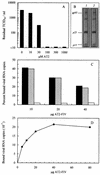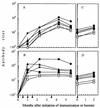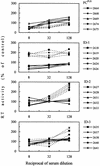AIDS vaccination studies using an ex vivo feline immunodeficiency virus model: failure to protect and possible enhancement of challenge infection by four cell-based vaccines prepared with autologous lymphoblasts
- PMID: 12072489
- PMCID: PMC136316
- DOI: 10.1128/jvi.76.14.6882-6892.2002
AIDS vaccination studies using an ex vivo feline immunodeficiency virus model: failure to protect and possible enhancement of challenge infection by four cell-based vaccines prepared with autologous lymphoblasts
Abstract
Immunogenicity and protective activity of four cell-based feline immunodeficiency virus (FIV) vaccines prepared with autologous lymphoblasts were investigated. One vaccine was composed of FIV-infected cells that were paraformaldehyde fixed at the peak of viral expression. The other vaccines were attempts to maximize the expression of protective epitopes that might become exposed as a result of virion binding to cells and essentially consisted of cells mildly fixed after saturation of their surface with adsorbed, internally inactivated FIV particles. The levels of FIV-specific lymphoproliferation exhibited by the vaccinees were comparable to the ones previously observed in vaccine-protected cats, but antibodies were largely directed to cell-derived constituents rather than to truly viral epitopes and had very poor FIV-neutralizing activity. Moreover, under one condition of testing, some vaccine sera enhanced FIV replication in vitro. As a further limit, the vaccines proved inefficient at priming animals for anamnestic immune responses. Two months after completion of primary immunization, the animals were challenged with a low dose of homologous ex vivo FIV. Collectively, 8 of 20 vaccinees developed infection versus one of nine animals mock immunized with fixed uninfected autologous lymphoblasts. After a boosting and rechallenge with a higher virus dose, all remaining animals became infected, thus confirming their lack of protection.
Figures


 ), or AT2-inactivated and then disrupted by sonication (□). After 2 h at 4°C, the PLB were pelleted and examined for bound FIV RNA copies by quantitative TM-PCR. The results are expressed as the percent viral RNA copies found associated with the cells relative to the number of input copies. (D) Dose curve of AT2-FIV binding to PLB. Indicated amounts of AT2-FIV were incubated with 5 × 105 PLB which, after 2 h at 4°C, were pelleted and examined as described above for bound viral RNA. The results are expressed as the numbers of viral RNA copies found associated with the cells.
), or AT2-inactivated and then disrupted by sonication (□). After 2 h at 4°C, the PLB were pelleted and examined for bound FIV RNA copies by quantitative TM-PCR. The results are expressed as the percent viral RNA copies found associated with the cells relative to the number of input copies. (D) Dose curve of AT2-FIV binding to PLB. Indicated amounts of AT2-FIV were incubated with 5 × 105 PLB which, after 2 h at 4°C, were pelleted and examined as described above for bound viral RNA. The results are expressed as the numbers of viral RNA copies found associated with the cells.


Similar articles
-
Efficacy evaluation of prime-boost protocol: canarypoxvirus-based feline immunodeficiency virus (FIV) vaccine and inactivated FIV-infected cell vaccine against heterologous FIV challenge in cats.AIDS. 1998 Jan 1;12(1):11-8. doi: 10.1097/00002030-199801000-00002. AIDS. 1998. PMID: 9456250
-
Immunization of cats against feline immunodeficiency virus (FIV) infection by using minimalistic immunogenic defined gene expression vector vaccines expressing FIV gp140 alone or with feline interleukin-12 (IL-12), IL-16, or a CpG motif.J Virol. 2000 Nov;74(22):10447-57. doi: 10.1128/jvi.74.22.10447-10457.2000. J Virol. 2000. PMID: 11044089 Free PMC article.
-
AIDS vaccination studies using an ex vivo feline immunodeficiency virus model: homologous erythrocytes as a delivery system for preferential immunization with putative protective antigens.Clin Diagn Lab Immunol. 1998 Mar;5(2):235-41. doi: 10.1128/CDLI.5.2.235-241.1998. Clin Diagn Lab Immunol. 1998. PMID: 9521149 Free PMC article.
-
Lessons Learned in Developing a Commercial FIV Vaccine: The Immunity Required for an Effective HIV-1 Vaccine.Viruses. 2018 May 22;10(5):277. doi: 10.3390/v10050277. Viruses. 2018. PMID: 29789450 Free PMC article. Review.
-
Feline immunodeficiency virus model for designing HIV/AIDS vaccines.Curr HIV Res. 2010 Jan;8(1):14-25. doi: 10.2174/157016210790416361. Curr HIV Res. 2010. PMID: 20210778 Free PMC article. Review.
Cited by
-
Enhanced SIV replication and accelerated progression to AIDS in macaques primed to mount a CD4 T cell response to the SIV envelope protein.Proc Natl Acad Sci U S A. 2004 Aug 31;101(35):13026-31. doi: 10.1073/pnas.0404739101. Epub 2004 Aug 23. Proc Natl Acad Sci U S A. 2004. PMID: 15326293 Free PMC article.
-
AIDS vaccination studies with an ex vivo feline immunodeficiency virus model: analysis of the accessory ORF-A protein and DNA as protective immunogens.J Virol. 2006 Sep;80(18):8856-68. doi: 10.1128/JVI.00397-06. J Virol. 2006. PMID: 16940498 Free PMC article.
-
Vaccine-associated enhanced disease in humans and animal models: Lessons and challenges for vaccine development.Front Microbiol. 2022 Aug 10;13:932408. doi: 10.3389/fmicb.2022.932408. eCollection 2022. Front Microbiol. 2022. PMID: 36033843 Free PMC article. Review.
-
Vaccine-induced enhancement of viral infections.Vaccine. 2009 Jan 22;27(4):505-12. doi: 10.1016/j.vaccine.2008.10.087. Epub 2008 Nov 18. Vaccine. 2009. PMID: 19022319 Free PMC article. Review.
-
Prior mucosal exposure to heterologous cells alters the pathogenesis of cell-associated mucosal feline immunodeficiency virus challenge.Retrovirology. 2010 May 28;7:49. doi: 10.1186/1742-4690-7-49. Retrovirology. 2010. PMID: 20507636 Free PMC article.
References
-
- Arthur, L. O., J. W. Bess, Jr., E. N. Chertova, J. L. Rossio, M. T. Esser, R. E. Benveniste, L. E. Henderson, and J. D. Lifson. 1998. Chemical inactivation of retroviral infectivity by targeting nucleocapsid protein zinc fingers: a candidate SIV vaccine. AIDS Res. Hum. Retrovir. 14:S311-S319. - PubMed
-
- Binley, J. M., R. W. Sanders, B. Clas, N. Schuelke, A. Master, Y. Guo, F. Kajumo, D. J. Anselma, P. J. Maddon, W. C. Olson, and J. P. Moore. 2000. A recombinant human immunodeficiency virus type 1 envelope glycoprotein complex stabilized by an intermolecular disulfide bond between the gp120 and gp41 subunits is an antigenic mimic of the trimeric virion-associated structure. J. Virol. 74:627-643. - PMC - PubMed
-
- Bishop, S. A., C. R. Stokes, T. J. Gruffydd-Jones, C. V. Whiting, J. E. Humphries, R. Osborne, M. Papanastasopoulou, and D. A. Harbour. 1996. Vaccination with fixed feline immunodeficiency virus (FIV)-infected cells: protection, breakthrough, and specificity of response. Vaccine 14:1243-1250. - PubMed
-
- Bogers, W. M. J. M., C. Cheng-Mayer, and R. C. Montelaro. 2000. Developments in preclinical AIDS vaccine efficacy models. AIDS 14:S141-S151. - PubMed
-
- Burton, D. R., and P. W. H. I. Parren. 2000. Vaccines and the induction of functional antibodies: time to look beyond the molecules of natural infection? Nat. Med. 6:123-125. - PubMed
Publication types
MeSH terms
Substances
LinkOut - more resources
Full Text Sources
Research Materials
Miscellaneous

